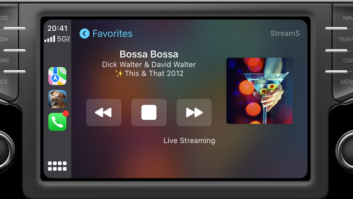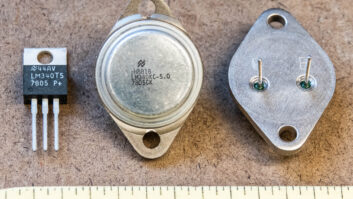While digital radio broadcasting has been far less than a killer application anywhere to date, there are signs of life showing in several venues.
Eureka-147 DAB receivers finally are beginning to move off the shelves in Europe and Canada. Automotive receivers are showing up in high-end vehicles in Germany and elsewhere, while small portables costing less than 100 pounds are particularly stimulating the market in the U.K.
New services provided in the latter zone by the BBC and commercial broadcasters are creating increased demand for DAB radios there. Some other European countries that had postponed or curtailed DAB service are reassessing their decisions, and early DAB datacasting is beginning in a few areas, including still and video images.
Much fanfare also greeted the recent launch of the Digital Radio Mondiale format, which provides digital service in the AM, MW and SW environments. This coordinated international process looks ready to hit the ground running, spurred on strongly by the participation of many state-sponsored broadcasters (including the Voice of America), who are anxious to replace their shortwave broadcasts with more — consistent and higher — quality service. DRM receivers are expected to be broadly and cheaply available around the world in 2004.
Satellite radio services in the United States continue to make headway, with corporate capitalizations and audience growth building a future that seems somewhat more secure for these still-nascent operations. While the goal of profitability is some distance away, the trends are positive for both XM Satellite Radio and Sirius Satellite Radio, with most analysts agreeing that the companies and their services are moving in the right direction. Meanwhile, Worldspace continues its development of satellite radio services elsewhere in the world.
Waiting for a green light
Yet American terrestrial radio broadcasters remain stuck at the starting gate, with no standard format approved and no receivers in the market.
At the moment, it remains unclear when (or even whether) those receivers will become available. The risk of deployment before standardization — never a good idea — could in this case seriously jeopardize the 2004 bottom lines for broadcasters who have speculatively purchased what may turn out to be useless equipment.
At this writing, the fate of U.S. terrestrial broadcasters’ digital transition remains in a single company’s hands. Ibiquity Digital Radio remains mute on how the current codec problem will be alleviated, although it continues to announce loudly broadcaster adoption of the crippled format. Ibiquity’s recent personnel shake-ups also do not bode well for the company’s overall future.
If its cost-cutting requirements are dire enough to cause the departure of some of its most valuable staff, we should all be concerned about the corporation’s ongoing viability. On the other hand, if that budgetary argument is a smokescreen, the company’s management sensibility comes into question; it has now lost its strongest liaison and credibility with the broadcast industry through these actions.
Either way, the unavoidable conclusion indicates that the future of Ibiquity is at risk like never before, and with it the future of digital radio for the U.S. terrestrial industry. Observers of this space who had questioned the nature of the corporate and intellectual property structures behind the U.S. DTV debacle are starting to view the American digital radio scene with an even more-jaundiced eye. It seems profoundly sad that after more than a decade of development, the digital conversion of U.S. terrestrial radio remains in such an immature, unstable and speculative state.
The FCC also should question its role in this matter, in pursuing an unprecedented process of releasing interim rules based on a single company’s technology prior to any standard-setting effort. After all the pain and criticism the commission has suffered in the DTV process, one is left only to infer that it is an organization that doesn’t learn from its mistakes.
Today terrestrial radio remains a viable medium in the United States, if only by default. How much longer these broadcasters can linger with current technology while others excel is a fundamental question, one that continues to threaten the prospects for U.S. terrestrial radio’s future.












